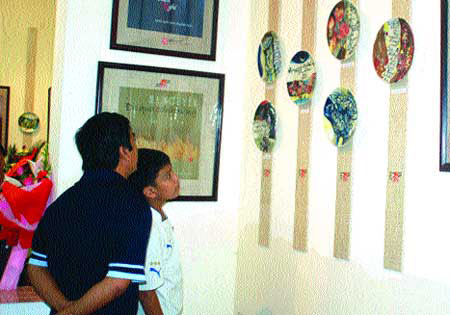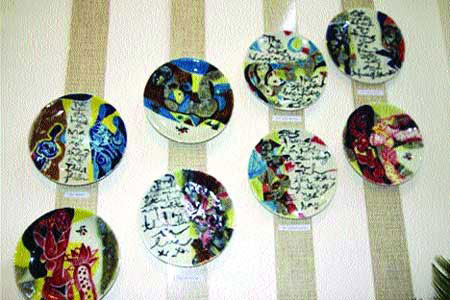
On the occasion of the 2010 Hue Festival, painter Tran Do Nghia unveiled 40 poetry-inscribed ceramic plates in the former royal city of Hue on the banks of the Huong River.
His works of art, made at the Bat Trang pottery village on the outskirts of Ha Noi along with book covers made by calligrapher Nguyen Phuoc Hai Trung, attracted a lot of viewers during the event.
Born in 1963, Nghia studied at the Ha Noi University of Fine Arts before pursuing further studies in Eastern Europe. After returning home, he started his art career by painting pictures, making pottery, and organizing exhibitions across the country. His love for traditional art heritage has drawn him to pottery villages, such as Phu Lang and Bat Trang.
Phu Lang Village is located in Que Vo District's Phu Lang Commune in the northern province of Bac Ninh.
Nghia stated that the village had been founded and developed during the Tran Dynasty in the 14th century and has a heritage of creating ceramics with special characteristics. Its ceramics have unique enamel colours, including dark brown, yellowish, and dark yellow.
During his first visit to the village, he developed a keen interest in discovering techniques of making pottery and decided to make regular trips on the weekends. These trips and his experience in making pen and pencil holders nurtured his passion, leading him to the world of pottery.
 |
|
On show: One of Nghia's exhibitions |
The village's products are made with red clay, mainly comprising three kinds: ceramics for worshippings, such as incense burners and lamp bases; ceramics for family use including vases, bowls and plates, and things used for decoration such as pictures and statues. Nghia focuses his efforts on creating decorative arts with creativity and change in appearance and enamel-based techniques to make ancient pottery products. Taking advantage of his network, he has constantly popularised the village's products within and outside the country.
In 2014, Nghia brought products of Phu Lang to display on the banks of Hoai River in Hoi An ancient town. The pottery jars, bearing the carvings of old streets and people of the town, attracted significant attention from the residents and tourists.
After achieving success with Phu Lang ceramics, Nghia continued learning about pottery in Bat Trang. While the original beauty of Phu Lang pottery is the nature of dark brown enamel, the specific characteristics of Bat Trang pottery is the diversity of enamels.
Bat Trang is situated more than ten kilometres from Ha Noi City's centre. Every day, Nghia drove his motorbike to the village to meet the local artisans and learn from them. As a result of this sharing, Nghia has grown closer to the local people who regard him as a member of their family.
"In the period of market economy, everything is measured in terms of money. It is very difficult to find a young person with great passion for pottery like Nghia. Not only we, but also other artisan families hold him in high esteem and support him," local artisan Nguyen Duc Duong claimed.
According to Nghia, during the period between 1989 and 90, the artisans did not understand why artists distorted and made holes in ceramic products. They thought that making products, such as jars could hold water, but distorted and holed products could not.
 |
|
Passion for pottery: He spends significant efforts on crafting ceramics. |
"When pottery artisans, such as Nguyen Trong Doan and Nguyen Bao Toan, altered the products, the local people felt sorry as they had put in many efforts to make them. They did not know that it could rouse ideas for new designs," Nghia exclaimed.
He emphasised the importance of a painter-sculptor in the village and expressed his sadness for Tho Ha pottery village's fading art form. The village, located in the neighbouring province of Bac Giang, was founded in the 12th century and used to be one of three ceramic centres in the north, besides Phu Lang and Bat Trang.
However, the residents have stopped making potteries and stories about the craft village are only found in documents. Nghia noted that there was an old man trying to revive the business but he failed and passed away a few years ago.
Spending a great deal of time in the two villages, Nghia witnessed a change in making pottery there.
"When I make ceramic products, I always use traditional enamel. Meanwhile, I now see products made at Phu Lang with colours that made them appear ludicrous. At the moment, the artisans are no longer devoted to their work. They make pottery products with the aim of earning money and do not consider it as a work of art," he pointed out.
When his friends went to Ha Noi, he often invited them to visit the villages to introduce them to the beauty of pottery and exquisite talent of the artisans.
At the beginning of this year, he drove a motorbike from Ha Noi to Hue and Da Nang cities with the objective of holding a new exhibition in the centre of the country. He also dreams of painting poems on ceramic products to display at Nguyen Tieu Festival, the full moon day of the first month in the lunar calendar, annually held on Nhan Mountain in the coastal province of Phu Yen.
Undying creativity has nurtured his passion for ceramics, and it has continuously opened up new horizons for the Hanoian artist.






